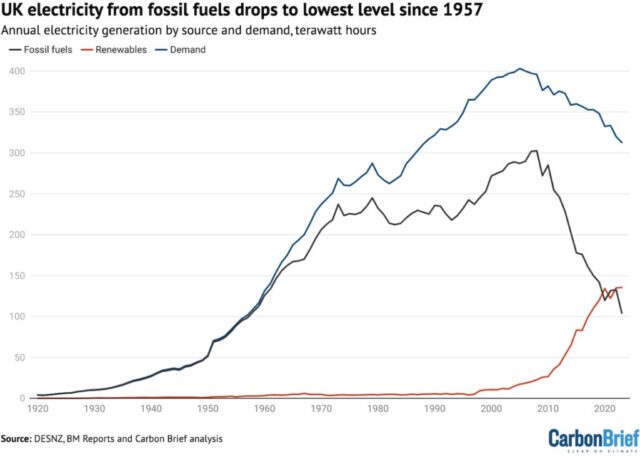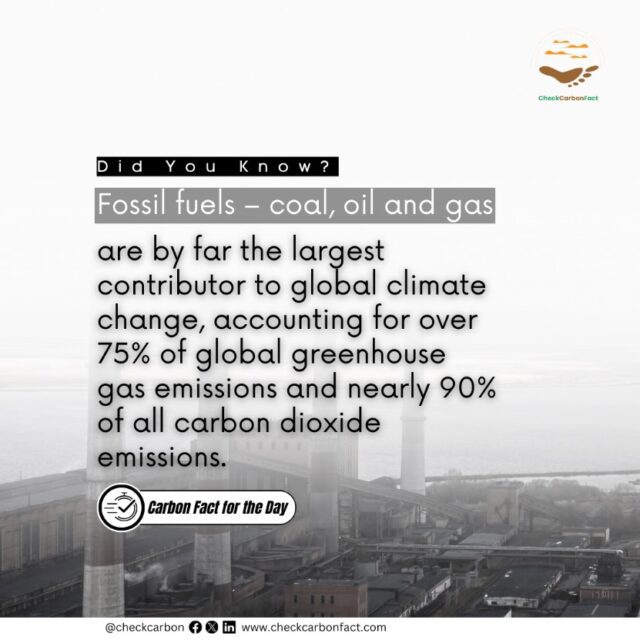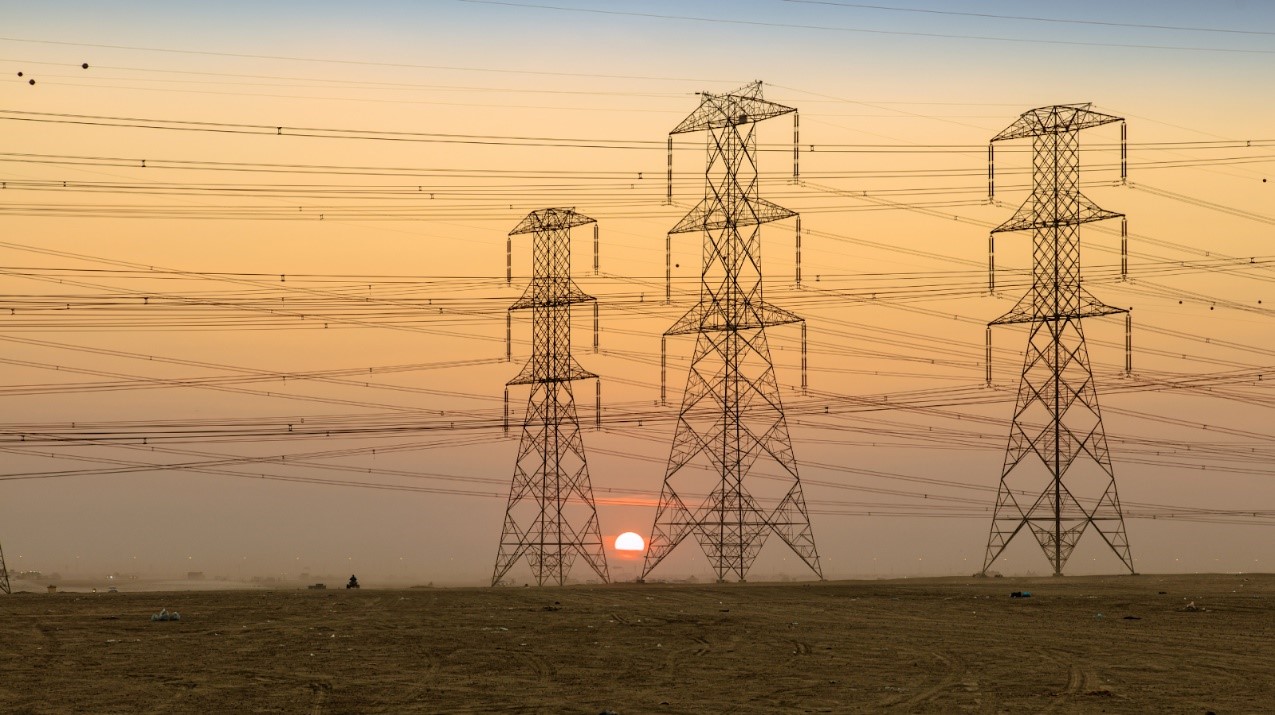In the past, the UK had a population of 51 million, which has now increased to around 67 million. Fossil fuels used to provide 97% of the country’s electricity. However, by 2023, this reliance on fossil fuels significantly declined, with their contribution dropping to 33% of electricity generation. Reports show that in 2008, fossil fuels reached their peak in electricity generation at 303TWh, but by 2023, it fell to 104TWh, its lowest level since 1957. The 104-terawatt hours (TWh) generated from fossil fuels in 2023 is the lowest level in 66 years.
This dramatic decline marks a pivotal shift in the nation’s energy landscape, driven by a combination of reduced demand and a surge in renewable energy generation. This blog will explore the situations surrounding this significant decline.
The Decline of Fossil Fuel Use and the Rise of Renewables
Coal has nearly disappeared from the UK electricity system. It is reported to drop by 97%, alongside gas, by 43% in the last 15 years. The decline in coal power is set to continue in 2024 with the scheduled closure of Britain’s final coal plant in September. Similarly, renewables and Britain’s nuclear reactors, which generated 13% of electricity supplies last year, helped low-carbon electricity make up 55% of the UK’s electricity in 2023.
In 2023, three of the UK’s four remaining coal-fired power stations shut down, leaving only Ratcliffe in Nottinghamshire operational, which is planned to close by September 2024. This marks significant progress towards the government’s ambition to end coal power by October 2024.
The decline in fossil fuel use is largely attributed to the rapid expansion of renewable energy sources, which have increased six-fold since 2008, producing 135TWh in 2023. Meanwhile, data show that overall electricity demand has fallen significantly from 396TWh in 2008 to 313TWh in 2023. This reduction in demand is equivalent to more than three times the expected output of the Hinkley Point C nuclear power plant, currently under construction.

Source: Carbon Brief
Renewable Energy Growth:
Renewable energy now plays a central role in the UK’s electricity generation mix. In 2023, renewables accounted for 43% of the total electricity supply, a record high. Wind energy, in particular, has seen substantial growth, with new projects such as the Seagreen offshore wind farm and the ongoing development of Dogger Bank, set to become the world’s largest offshore wind farm. However, since reaching 134TWh in 2020, renewable output has plateaued, recording 135TWh in both 2022 and 2023. This stagnation reflects a balance between increasing wind and solar capacity, varying weather conditions, and reduced bioenergy output.
Breakdown of Renewable Electricity in 2023:
- Wind: 82TWh, a 2% increase year-on-year.
- Bioenergy: 35TWh, down 13% from 2021.
- Solar: 14TWh, a 2% increase year-on-year.
- Hydro: 5TWh, a 9% drop year-on-year.
- Wind and Solar Capacity
Wind energy has been the cornerstone of the UK’s renewable energy strategy. In 2023, wind power generated 82TWh of electricity, up 2% from the previous year. The UK has invested heavily in both onshore and offshore wind projects, with capacity increases of 0.6GW and 1.1GW respectively in 2023. Despite below-average wind speeds for much of the year, a particularly windy December helped set a new wind generation record of 21.8GW on 21 December, accounting for 56% of the electricity mix at its peak.
- Bioenergy
Data showed that bioenergy contributed 35TWh to the UK’s electricity in 2023, down from the 40 TWh produced in 2020 and 2021. Bioenergy primarily involves the combustion of plant biomass, such as wood chips, with the Drax plant in Yorkshire being a significant source (2.6 GW capacity for biomass). However, output from bioenergy has been subdued recently, influenced by changes in incentives and operational factors.
Description: Great Britain’s electrical generation by fuel type %
Source: The Conversation
- Solar Energy
Solar power, while smaller in total output compared to wind, has seen steady growth. In 2023, solar generation reached 14TWh, a 2% increase year-on-year. The United Kingdom’s cumulative PV capacity reached 15.6 GW at the end of November 2023, with projections indicating continued growth to 25GW by 2025. This increase follows a period of stagnation, reflecting renewed investment and deployment of solar installations.
- Hydropower
Hydropower, though the smallest contributor among the major renewable sources, plays a crucial role in the UK’s renewable energy landscape. Analysis from Statista showed that in 2023, hydropower capacity in the United Kingdom amounted to nearly 4.8 gigawatts. This is the same value recorded the previous year. Despite its smaller scale compared to wind and solar, hydropower offers unique advantages such as reliability and flexibility. Hydropower plants can quickly adjust their output to match demand, providing a valuable balancing service to the grid, especially during periods of peak demand or intermittent supply from other renewables.
The UK’s hydropower capacity, primarily located in Scotland, is well-established, and while opportunities for significant new large-scale projects are limited due to geographical and environmental constraints, there is potential for upgrading existing facilities and developing small-scale hydro projects. These efforts can help maximize the contribution of hydropower to the renewable energy mix, ensuring it remains a vital part of the UK’s strategy for a stable and sustainable energy future.
Electricity Imports and Exports
The UK’s electricity imports and exports play a crucial role in balancing its energy needs and maintaining grid stability. The UK’s engagement in electricity imports and exports began with the establishment of its first interconnector with France in 1986. This infrastructure laid the groundwork for subsequent interconnectors with other neighbouring countries, enhancing the UK’s ability to trade electricity and stabilize its grid. As of late 2023, the UK boasts 8.4 gigawatts (GW) of interconnector capacity. This capacity includes connections with France, the Netherlands, Belgium, and Norway, providing diverse sources of imported electricity.
The trend of electricity imports and exports has fluctuated over the years, influenced by domestic generation capacity, demand, and the availability of electricity from neighbouring countries. In 2023, the UK transitioned back to being a net importer of electricity, reported to have purchased 23TWh from countries such as France, the Netherlands, Belgium, and Norway, a figure similar to that of 2021 (25TWh). This shift from being a net exporter of 5TWh in 2022 to net imports of 23TWh in 2023, alongside consistent renewable energy output and decreasing demand, contributed to a reduced reliance on fossil fuels.
The ability to import electricity has significant implications for the UK’s domestic electricity generation mix, particularly in reducing reliance on fossil fuels. In 2023, the combination of steady renewable output, reduced demand, and increased imports contributed to a substantial decrease in fossil fuel generation. This decline is part of a longer-term trend of decreasing fossil fuel dependence, facilitated by the availability of imported electricity when domestic renewable generation is insufficient.
Interconnector Developments
The UK has made significant expansions in its interconnector network. Notably, the Viking Link interconnector between the UK and Denmark, with a capacity of 1.4GW, was completed and began operating on 29 December 2023. Furthermore, there are plans to increase interconnector capacity significantly. An additional 4.7GW of interconnector projects have received regulatory approval, with further projects totaling 5.6GW in the pipeline. The UK now has 8.4 gigawatts (GW) of interconnector capacity to link its electricity system with that of neighbouring countries, including a power link to Belgium. These future expansions will enhance the UK’s ability to import and export electricity, providing greater flexibility and resilience in the national grid.
Interconnectors play a strategic role in the UK’s energy security and sustainability goals. They allow for the balancing of supply and demand across borders, enabling the UK to import electricity during periods of low domestic renewable generation (e.g., during periods of low wind or solar output) and export excess electricity when renewable generation is high. This flexibility is essential for integrating intermittent renewable sources into the grid and ensuring a reliable electricity supply.
Carbon Intensity and Future Goals
Record Low Carbon Intensity:
Britain’s electricity is now cleaner than ever. Electricity Insight showed that in the second quarter of 2023, the generation mix emitted only 143 grams of CO2 per kWh. This marks the first time that the milestone of 150 g/kWh has been surpassed over a quarter, a record not broken since the early 2020 COVID lockdowns. The carbon intensity metric reflects the amount of carbon dioxide emissions produced per unit of electricity generated, serving as a key indicator of environmental performance and the effectiveness of decarbonization strategies.
Drivers of Carbon Intensity Reduction:
The reduction in carbon intensity can be attributed to several factors:
- Shift to Renewables: The most significant driver has been the rapid growth in renewable energy sources, particularly wind and solar power. As these technologies generate electricity without direct carbon emissions, their increased share in the energy mix directly reduces overall carbon intensity.
- Decline in Fossil Fuels: The dramatic decrease in coal usage has played a crucial role. Coal is the most carbon-intensive form of electricity generation, and its phase-out has significantly cut emissions. Similarly, the reduction in natural gas usage, which emits less CO2 than coal but more than renewables, has further contributed to lowering carbon intensity.
- Energy Efficiency Improvements: Advances in energy efficiency across various sectors, including more efficient power plants and industrial processes, have also helped reduce emissions per unit of electricity generated.
- Technological Innovations: Innovations in grid management and storage technologies have improved the integration of renewable energy, making the electricity supply more resilient and less reliant on fossil fuels during periods of high demand.
Future Goals and Challenges:
The UK government has set ambitious targets to further reduce the carbon intensity of electricity generation. The goal is to bring it down to below 100gCO2/kWh by 2030 as part of the broader strategy to achieve net-zero emissions by 2050. This will require substantial advancements and investments across several areas:
- Increased Renewable Capacity: The government aims to expand renewable energy capacity significantly. For offshore wind alone, the target is to reach 50GW by 2030 (even though ast year the country fell behind its target to build 50GW of offshore wind by 2030 when an auction round failed to attract a single bid). Achieving this will involve accelerating the development and deployment of new wind farms and other renewable projects.
- Energy Storage and Grid Infrastructure: As the share of intermittent renewable energy sources like wind and solar increases, so does the need for robust energy storage solutions and grid infrastructure. This includes the development of large-scale batteries, pumped hydro storage, and advanced grid management systems to ensure a stable and reliable electricity supply.
- Decarbonizing Bioenergy: Bioenergy contributes to the renewable energy mix but can have associated lifecycle emissions depending on the feedstock and processing methods used. Optimizing bioenergy to minimize its carbon footprint will be essential for meeting the overall carbon intensity targets.
- Electrification of Other Sectors: The electrification of transport, heating, and other sectors will increase electricity demand. Ensuring that this additional demand is met with low-carbon electricity will be crucial for maintaining progress towards overall emissions reduction targets.
- International Cooperation and Imports: The UK’s energy strategy also involves increasing interconnector capacity with neighbouring countries, facilitating the import and export of electricity. Ensuring that imported electricity is low-carbon is essential for accurately accounting for and reducing the UK’s carbon footprint.
Achieving these goals will require strong policy and regulatory support from the government. This includes:
- Incentives and Subsidies: Continued financial incentives for renewable energy projects, such as subsidies and tax credits, to encourage investment and development.
- Research and Development: Funding for research and development in new technologies that can enhance the efficiency and effectiveness of renewable energy and storage solutions.
- Regulatory Frameworks: Implementing regulatory frameworks that support the integration of renewables into the grid and ensure the reliability and stability of the electricity supply.
Challenges Ahead
The decade ahead presents a new set of challenges for the UK in its pursuit of further reducing coal and natural gas generation. Despite the significant progress made, achieving an additional 30% point reduction in fossil fuel-generated electricity by 2030 will be more complex. This goal would mean reducing fossil fuel reliance to just one-sixth of the country’s electricity supply.
- Rising Electricity Demand:
Unlike the past decade, where electricity demand remained relatively stable or even declined, the next ten years are expected to see a rise in electricity consumption. This increase is driven by the electrification of transport and heating. The growing adoption of electric vehicles (EVs) and electric heating solutions will significantly add to the overall electricity demand. For instance, if all UK cars and taxis were electric, the total electricity demand could rise by over 80 TWh annually, requiring the equivalent of three large nuclear plants like Hinkley Point C to meet this new demand.
- Need for Increased Renewable Capacity:
To replace an estimated 100 TWh per year of fossil fuel generation, the UK will need to ramp up its renewable capacity significantly. This involves not only expanding existing sources like solar and wind but also investing in new technologies such as tidal, marine, and advanced biomass generation. Achieving this will require a build program roughly 50% larger than the efforts of the past nine years. The continued development of offshore wind, along with falling costs for solar and wind energy, provides some optimism. The UK’s business and energy secretary, Greg Clark, has even suggested that green power could become the cheapest power source by the mid-2020s, potentially requiring zero subsidies.
- Flexibility and Infrastructure Development:
Incorporating higher levels of variable renewable energy necessitates additional grid flexibility and substantial infrastructure upgrades. The UK must develop advanced energy storage solutions and smart grid technologies to handle the intermittent nature of renewable sources. As electric vehicles gain market share, there will be substantial new infrastructure costs, including more pylons and stronger substations, to accommodate peak demand periods. A smarter system where EVs can charge during off-peak times or even feed electricity back to the grid could provide the necessary flexibility. This would require enhanced communication and coordination between vehicle owners, manufacturers, and power companies.
- Economic and Policy Considerations:
The transition also involves significant economic and policy considerations. The loss of fuel duty revenue, estimated at around £28 billion annually, will need to be addressed. Policymakers must find alternative revenue sources to fund public services and infrastructure projects. Furthermore, ongoing financial incentives and regulatory support will be essential to encourage investment in renewable energy and energy efficiency technologies.
Looking Ahead
The UK’s shift away from fossil fuels in electricity generation is a remarkable achievement, reflecting significant strides in renewable energy development and efficiency improvements. While the path to further reducing fossil fuel dependency in the UK’s electricity generation mix is paved with challenges, with continued technological advancements, supportive policies, and strategic investments, these challenges can be surmounted. The goal of a low-carbon, sustainable energy future remains achievable, but it will require concerted effort and innovation across all sectors of the economy. With fossil fuels now contributing their lowest share ever to the UK’s electricity mix, the nation is on a promising path toward a sustainable and low-carbon energy future. However, continued investment, innovation, and policy support will be crucial to overcoming the remaining challenges and achieving the ambitious goals set for the coming decades
About CheckCarbonFact
CheckCarbonFact is a social accountability platform for promoting sustainability and responsible climate action by citizens, businesses and government. Read more about us here: https://checkcarbonfact.com/about/
Carbon Fact for the Day

Found it interesting and would like more in the mail?




